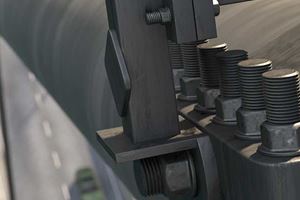Get engineering and bolting insights delivered straight to your inbox. Subscribe to our insights newsletter now!
Bolt Locking Methods
When choosing a method for preventing bolts from loosening in an assembly there are many different options. One needs to assess the risk of joint failure and the dynamic loads the joint will meet during the life of the assembly. Only then can one choose from some of the more commonly used principles and from there find a solution that will be suitable for the unique assembly at hand. All bolted joints are unique and should be treated as such.
| Locking methods | Explanation |
|
Friction
|
Friction locking methods are based on preventing surfaces from sliding against each other by increasing the resistance (friction) between these contact surfaces. Increased friction between the male and female threads, or between the fastener and contact surface, creates resistance to loosening. Common friction-based bolt locking products: |
|
Mechanical
|
Mechanical locking utilizes a physical barrier with the aim of preventing the fastener from rotating. Mechanical locking devices include tab washers, which have a side tab that can be bent upwards to lock the nut in place, and locking wire, which can be threaded through a hole in the bolt head/nut and tightened to another fastener close by. Both can prevent the fastener from rotating fully, but it should be noted that a proportion of the preload can be lost over time under dynamic load conditions. Common mechanical bolt locking products: |
|
Adhesive
|
This method uses a liquid, known as thread-locking adhesive, to prevent a bolted joint from loosening. The adhesive is applied to the thread of the fastener. Adhesives are not restricted by the size of the fastener used; however, they do pose a risk of chemical exposure and may be hazardous to health. They can also have a significant adverse effect upon the torque/load ratio, resulting in uncontrolled preload during tightening. |
|
Geometry
|
The geometry method utilizes the shape of the fastener to secure the bolted joint in place when subjected to vibration and dynamic loads. The most common system, wedge-locking washer, is composed of a pair of washers with cams on one side and serrations on the other. The serration forces any rotational movement to occur between the washers and the geometry of the cams introduces a need for an increase in tension in the bolt if the bolts want to rotate loose. This safely secures the joint. |
|
Non-locking
|
There are some products that do not have a locking function. They might be commonly used due to ease of procurement, but the main purpose is mostly to protect the mating surface of the application. Common non-locking products: |
From a more advanced technical perspective, there are other considerations to every unique bolted connection, ranging from lubrication, settlements, mating surface and operating conditions.
What happens to an unsecured bolted joint? Find out in the video below.
Like this article and want more?

Which bolt locking product should I use?
Get your free eBook on the topic of bolt loosening and see how different bolt locking products perform.
What you will find in the eBook:
- Pros and cons of the different bolt locking methods
- Evaluation of different products
- A print-friendly Guidance for Selection, to help you decide which product to use in your applications












